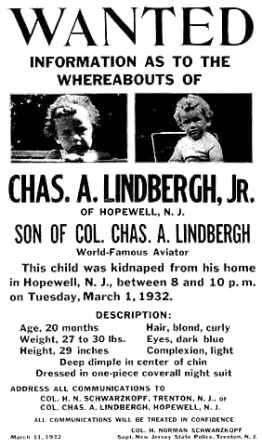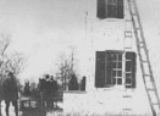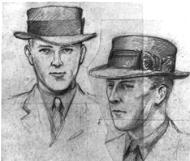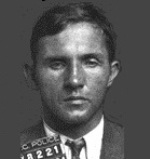|

Poster detailing the
Lindbergh
Kidnapping
|
Lindbergh Kidnapping
Facts: Fast Fact Sheet for kids
Fast, fun facts and Frequently Asked Questions (FAQ's)
about the Lindbergh Kidnapping.
What happened in the Lindbergh Kidnapping?
The Lindbergh
Kidnapping, referred to by the press of the
time as "The Crime of the Century", was the
abduction of the 20-month-old Charles
Augustus Lindbergh, Jr., the son of aviator
Charles Lindbergh and his wife Anne.
When did the Lindbergh Kidnapping happen?
The Lindbergh Kidnapping occurred on the
evening of Tuesday March 1, 1932
Where was the baby taken from?
20-month-old Charles Lindbergh, Jr., was
abducted from his crib in the second-story
nursery of the family's home in East Amwell,
New Jersey, near the town of Hopewell.
What was the ransom in the Lindbergh
Kidnapping?
The kidnapping led to a 10-week nationwide
search and the payment of a ransom of
$50,000 on April 2, 1932.
What happened to the baby in the
Lindbergh Kidnapping?
The child was never returned to his parents.
He was murdered by his kidnapper and the
child's remains were found six weeks later
on May 12, 1932 in roadside woodlands near
Mount Rose, New Jersey.
Who was the kidnapper? The name of
the kidnapper was Bruno Richard Hauptmann,
who was convicted of the crime, sentenced to
death and electrocuted at Trenton State
Prison on April 3, 1936.
Lindbergh
Kidnapping
Facts for kids
The following fact
sheet contains interesting facts and information on Lindbergh
Kidnapping
Facts about
the Lindbergh Kidnapping for kids
Lindbergh Kidnapping Fact 1:
The tragic Lindbergh Kidnapping
attracted worldwide attention and led to a macabre media
circus in which the press hailed the abduction as "The
Crime of the Century".
Lindbergh Kidnapping Fact
2: Charles Lindberg Senior was the world
famous aviator who had become a celebrity following the
first solo, non-stop flight across the Atlantic Ocean in
his airplane
called the Spirit of St. Louis in
May 1927.
Lindbergh Kidnapping Fact 3:
The famous aviator married Anne Morrow, the daughter
of Dwight Morrow, the U.S. ambassador to Mexico on May
1929.
Lindbergh Kidnapping Fact 4:
The couple had a son, named Charles Lindbergh,
Jr., on June 22, 1930 and set up home in East Amwell, New Jersey,
near the town of Hopewell.
Lindbergh Kidnapping Fact 5:
The baby's nursery was on the second-story of the
house
Lindbergh Kidnapping Fact 6:
The child’s abduction was discovered
and reported to his parents, who were at home at the
time, by the child’s nurse, Betty Gow, at approximately
10:00 p.m. on Tuesday March 1, 1932.
Lindbergh Kidnapping Fact 7:
The police were
called and made a thorough search of the premises. They
discovered a ransom note, demanding $50,000, on the
nursery window sill. The were no fingerprints or blood
stains at the scene of the crime but footprints, that
were impossible to measure, were found under the nursery
window. The picture shows the Lindberg home with a
ladder leading up to the second floor nursery.

Lindbergh Kidnapping Fact 8:
Nationwide appeals were made by the
police to start negotiations with the kidnappers.
Posters, like the one above, were distributed across the
United States. Private Investigators were hired by the
family to help in the search.
Lindbergh Kidnapping Fact
9: A second ransom note was received by
Charles Lindbergh on March 6, 1932. The second
ransom note was postmarked Brooklyn, New York and dated
March 4, 1932. The ransom demand was increased to
$70,000.
Lindbergh Kidnapping Fact
10: A series of ransom notes, thirteen in
total, were received from the kidnapper and the
ransom was eventually agreed at the original figure of
$50,000.
Lindbergh Kidnapping Fact 11:
Dr. John F. Condon (Code name "Jafsie"), a
retired school principal from New York City acted as a volunteer
intermediary. Communications were conducted with the kidnapper via
pre-arranged advertisements in newspapers.
Continued...
Facts about
the Lindbergh Kidnapping for kids
Facts
about the Lindbergh Kidnapping for kids
The following fact
sheet continues with facts about Lindbergh Kidnapping for kids.
Facts about
Lindbergh Kidnapping for kids
Lindbergh Kidnapping Fact 12:
This sixth note gave
instructions for Dr. Condon to met an unidentified man, who called
himself "John" at Woodlawn Cemetery in New York City. They discussed
payment of the ransom money and the use of code words.
"John" agreed to furnish
a token of the child’s identity. Dr. Condon described "John" as
Scandinavian and gave the FBI as description of the man as shown in
the opposite picture and were used in investigations to identify the
mysterious "John".

Lindbergh Kidnapping Fact 13:
The baby’s sleeping suit, as a token of identity,
was received by Dr. Condon on March 16, 1932 and was identified by
Colonel Charles Lindbergh.
Lindbergh Kidnapping Fact 14:
The series of communications resulted
in the payment on April 2 of $50,000 was made partly in
cash and more easily traceable Gold certificates with
serial numbers.
Lindbergh Kidnapping Fact 15:
The information given about the
child's whereabouts proved to be false.
Lindbergh Kidnapping Fact 16:
Six weeks later on May 12, 1932, the
child's remains were found by chance by a passing truck
driver in woodlands along the roadside near Mount Rose,
New Jersey.
Lindbergh Kidnapping Fact 17:
On May 26, 1932 the New Jersey State
Police announced the offer of a reward of $25,000 for
information that resulted in the conviction of the
kidnapper or kidnappers.
Lindbergh Kidnapping Fact 18:
On June 13, 1932 the "Lindbergh Law"
was passed by Congress and signed by President Hoover.
Known formally as the "Federal Kidnapping Act of 1932"
the law enabled federal authorities to pursue kidnappers
once they had crossed state lines with their victim.
Lindbergh Kidnapping Fact 19:
Despite intensive investigations over
a period of a year and a half "John" was not identified.
But "John" made the mistake of cashing the $10 and $20
gold certificates which were a form of paper currency.
Lindbergh Kidnapping Fact
20: By tracing of the serial numbers of
$10 and $20 gold certificates (paper currency) passed in
the New York City area police at last led to "John". His
name was Bruno Richard Hauptmann, a 34-year-old German
immigrant carpenter.
Lindbergh Kidnapping Fact
21: Hauptmann had begun to pay various
stores with the gold certificates and a suspicious gas
station attendant noted the license plate number of his
automobile and reported this and the $10 gold
certificate number to the police.
Lindbergh Kidnapping Fact
22: Bruno Richard
Hauptmann was arrested near his home in the Bronx, New
York, on September 19, 1934. He had a criminal record
for robbery and had spent time in prison. The police
searched his home and found $13,760 of the ransom money
hidden in his garage. Bruno Richard Hauptmann was
identified by Dr. Condon as “John” to whom the ransom
had been paid. By September 26, 1934 Hauptmann had been
indicted on charges of kidnapping, extortion, and
first-degree murder. Hauptmann bore a remarkable
likeness to the FBI sketch.

Lindbergh Kidnapping Fact
23: On January 2, 1935 Bruno Richard
Hauptmann went on trial in Flemington, New Jersey. He
was convicted by the jury on all counts. The trial
judge, Thomas Trenchard, sentenced Hauptmann to death on
February 14, 1935.
Lindbergh Kidnapping Fact
24: Bruno Hauptmann adamantly maintained
his innocence, but his appeals and petitions for
clemency were all rejected. He was electrocuted at
Trenton State Prison on April 3, 1936.
Lindbergh Kidnapping Fact
25: It is impossible to imagine the
torment, pain and anguish suffered by Anne and Charles
Lindbergh. The brave couple went on to have another four
children following WW2.
Lindbergh Kidnapping Fact
26: The tragic Lindbergh Kidnapping was
undoubtedly the "Cruelist Crime of the Century"
Facts about
Lindbergh Kidnapping for kids
Facts
about
Lindbergh Kidnapping for
kids:
Charles Lindberg
For visitors interested in Charles Lindberg refer to the following articles:
Lindbergh Kidnapping - President Herbert Hoover Video
The article on the
Lindbergh Kidnapping provides detailed facts and a summary of one of the important events during his presidential term in office. The following
Herbert Hoover video will
give you additional important facts and dates about the political events experienced by the 31st American President whose presidency spanned from March 4, 1929 to March 4, 1933.
Lindbergh Kidnapping - President Herbert Hoover Video
The article on the Lindbergh Kidnapping provides detailed facts and a summary of one of the important events during his presidential term in office. The following
Herbert Hoover video will
give you additional important facts and dates about the political events experienced by the 31st American President whose presidency spanned from March 4, 1929 to March 4, 1933.
Lindbergh Kidnapping
●
Interesting Facts about Lindbergh Kidnapping for kids and schools
●
Summary of the Lindbergh Kidnapping in US history
●
The Lindbergh Kidnapping, a major
event in US history
●
Herbert Hoover from March 4, 1929 to March 4, 1933
●
Fast, fun facts about the Lindbergh Kidnapping
●
Foreign & Domestic
policies of President Herbert Hoover
● Herbert Hoover Presidency and
Lindbergh Kidnapping for schools,
homework, kids and children |